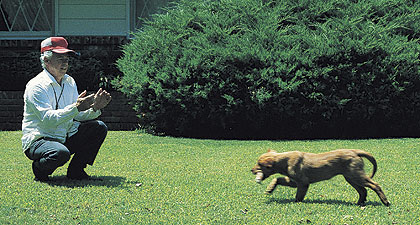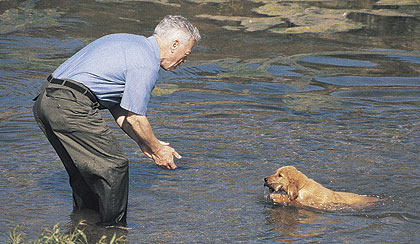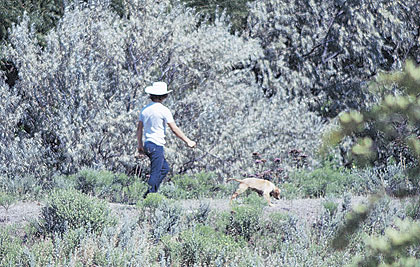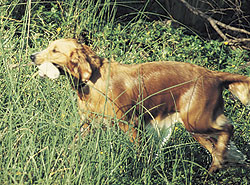When pup accepts who's boss, it's time.
By James B. Spencer
Most first-time retriever puppy buyers "read the directions" and do a good job of introducing their youngsters to retrieving, to the sit and come commands, to water, and maybe even to birds.
 Most beginners do quite well in introducing their puppies to retrieving. |
Not infrequently by the time the pup is four months old, he's doing 80-yard retrieves in the park and 40-yarders in the park pond. But many beginners forget to introduce their puppies to cover.
This is especially true among people who live in large cities, where the only nearby cover is in the typically too-well-manicured rough on the golf course. Just getting out into the country where real cover is available might take a 30- to 60-minute drive. Somehow that drive just never happens.
At least not until the neophyte joins the local retriever club and takes his, say, six-month-old Super-Puppy to a club training session.
 Most do well in introducing their puppies to water. |
Here's what can happen, at least to the more competitive beginner. Our hero watches several other puppies of similar ages do a 50-yard single mark on land, in moderate cover. It looks quite simple, even too simple, so he insists on running Super-Puppy on it right away.
He even asks that the "guns" move out another 50 yards, but cooler heads insist that he do the shorter one first. Agreeing reluctantly, he takes Super-Puppy to the line, signals for a throw, and sends S-P.
S-P takes off most impressively, but stalls out as he enters the cover a few yards from the line. S-P's body language is screaming, "Hey, what is this stuff? It smells funny and I can't see where I'm going." He returns to our greatly embarrassed hero, who sends him again.
"Now you get out there and find that bird, damn it!" And again. "Hey, what's the matter with you?" And again. "Get back! Fetch up that bird!" And so on until, furious, he picks S-P up, flings him into his car, and spins rubber as he leaves. Chances are he will never return. Pity. If he had first introduced S-P to cover, the otherwise well-prepared youngster would surely have made our hero proud at that club training session.
The above is, of course, a worst-case scenario. But many more cautious beginners suffer lesser embarrassments every year. So here's how you should introduce your puppy to cover and thereby avoid such un-pleasantries.
Prerequisites
You should start exposing your new puppy to cover as soon as he accepts you as his benevolent boss, knows his name, and gets your drift when you say "No." If you were still a stranger to him, he might wander off in cover and get lost. Fortunately, if he is properly bonded with you, you've necessarily already taught him his name and "No." With those two words, you can control him adequately during his initial romps afield.
If you're a city-dweller, perhaps finding a suitable location within a reasonable driving distance of home will be your most challenging "prerequisite." Basically, you need one or more reasonably large fields, of light to moderate cover, in which your puppy can safely run free. Why not heavy cover? For the same reason you wouldn't expect a child to attempt algebra before he had mastered basic arithmetic. Save heavy cover for later.
 To introduce a puppy to cover, you should begin with light stuff and gradually move into heavier |
Safety should be a major concern. For obvious reasons, avoid fields near busy roads. Similarly, steer clear of fields that have "hazards" in which your puppy could injure himself: trash heaps, discarded vehicles and equipment, broken bottles, rolls of rusty wire, deep holes in otherwise even terrain, and so forth. It's impossible to list all such hazards, but these should give you an idea of what to look for when you inspect a piece of cover before taking your puppy into it.
Then, too, you should avoid fields with live "hazards": skunks, badgers, bobcats, coyotes, poisonous snakes, bees, hornets, fire ants, and an almost unlimited list of other critters that can harm your puppy, not to mention your vulnerable self. Depending on your own susceptibility, you may or may not want to add poison ivy and poison oak to this list. For information on all such live hazards, you should, if possible, rely on the word of others, like whoever recommended the place to you.
Finally, common sense says you should avoid fields where livestock roams or crops grow. Then, too, free-running farm dogs may not be of the friendliest sort.
With all these prohibitions, how on earth can you, a city-dwelling retriever neophyte, find even one suitable field in which to expose your puppy to cover? Well, for starters, join the local retriever club, which almost certainly has appropriate nearby land leased that members can use. Then, as you become acquainted with other members (and convince them that you're at least harmless and perhaps downright helpful), they'll take you to other suitable areas.
To contact your local retriever club, check with your puppy's breeder or your veterinarian. Or check these websites: www.akc.org and www.ukcdogs.com.
Process
In general, you should simply turn your puppy loose and let him explore on his own. Be quiet so you don't distract him. At first, he may just follow you around. If he does, stop and stand still now and then. Eventually, he'll go off on his own, which is what you want.
As long as he's not in any danger, let him romp about, soaking up all these new scents, sounds, sights, and "feels." You want him to get so used to them that they won't distract him later on when you give him marks and blinds in cover.
You should carry a lead, just in case. I prefer the retractable type, which allows the dog a little running room without tangling around my aging and less than agile person. You should also carry drinking water for him, especially in warm weather.
 A puppy properly introduced to cover won't be distracted by it later on when he begins doing marks and blinds. |
If something harmless frightens him and he runs back to you, reassure him, but don't baby him, lest you reinforce his fear. Simply tell him it's okay and keep walking. He'll settle down quite quickly that way.
If he flushes and chases a songbird, great! Let him chase it as far as he likes, and say nothing to distract him. If he flushes and chases a rabbit, let him chase it. If he flushes and chases a gamebird, wonderful! Let him chase it.
If he flushes a gamebird and is frightened by its sudden noisy departure, ignore him and act as if nothing happened. Just keep walking. All these "contacts" will benefit him later on.
Keep each session relatively short, no more than half an hour. But do them as often as you can, and in as many different locations as you can. As his comfort level increases, add heavier cover, at least occasionally. You want him to be so used to all sorts of cover that none of it will ever distract him when he's "clocked in and on the job."
Follow-on
Even after your puppy is completely comfortable in all manners of cover, you can turn at least occasional romps to your and your puppy's training advantage.:
Examplae gratia I:
When he flushes and chases a gamebird, after he's at least 50 yards away from you and still chasing hard, you can fire a .22 blank pistol to start the gun-proofing process very gently. Spaniel trainers use this technique to great advantage, and so can you.
Examplae gratia II:
After you've trained him to sit and to come on whistle signals, you can occasionally stop him and/or call him back to you while he's romping merrily here and there. This will prepare him for upland hunting the easy way, that is, hunting on his own ahead of you, but kept within gun range by those two whistle signals.
Examplae gratia III:
After you've trained him to take your arm signals at a distance, ala blind retrieve, when you stop him with a whistle signal during these romps, you can toss a dummy off to either side, or between you and him, or way back behind him, and then cast him to said tossed dummy.
Incidentally, doing this will not only improve his casting, but will also do wonders for his response to your Sit-whistle. If he knows you're about to toss a dummy, he'll skid to a stop when he hears the whistle.
And so on. Clearly, if you're the imaginative type, you'll find all sorts of practical uses for these romps. You'll start adding one to the end of each training session. Great idea!
Editor's Note:
Jim Spencer's books can be ordered from the Gun Dog Bookshelf: Training Retrievers for Marshes & Meadows; Retriever Training Tests; Retriever Training Drills for Marking; Retriever Training Drills for Blind Retrieves; Retriever Hunt Tests; HUP! Training Flushing Spaniels the American Way; and POINT! Training the All-Seasons Bird Dog.






